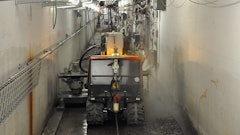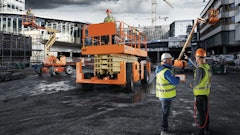
Carrying pallets of building materials and supplies. Relocating barriers around highway projects. Lifting and placing insulation, plywood and shingles onto roofs.
Moving trees around a nursery. Drilling holes to construct fencing on a farm.
This is just a short list of what today's telehandlers are doing on jobsites in construction, masonry, agriculture, landscaping and nursery applications. They can also be found assisting with highway work, such as bridge and overpass construction or repair, and industrial or steel building construction. What's the secret to their versatility?
Attachments
With many attachments to choose from-including pallet forks, buckets, drywall carriages, scrap grapple buckets, angle brooms, augers, truss booms and more-it's not uncommon to find telehandlers tackling a variety of functions that were previously performed by other machines.
Additionally, some makes of telehandlers feature hydraulic quick couplers for fast attachment changes and others are capable of powering skid-steer attachments directly or via a universal adaptor, further enhancing telehandler productivity and efficiency.
Another feature-their steering capability-adds to their versatility. "When the crab, two-and four-wheel steering capability of today's telehandlers meet with attachment options such as tilt and swing carriages, for instance, operators can effortlessly maneuver through tight, confined areas and still pick and place materials through windows or door openings," says Mike Saad, commercial marketing manager with Ingersoll-Rand.
Evolving into a "power unit
The challenge for rental businesses is to overcome their customers' mind sets that telehandlers are just lift-and-place machines, says Eric Brown, telescopic tool carrier product specialist with Bobcat.
"Telehandlers can do so much more, he explains".As a matter of fact, the number one attachment for Bobcat VersaHandlers in the rental industry is the auger. When most people think of telehandlers, however, the obvious attachment that comes to mind is forks because they think of telehandlers as lift machines.
"Telehandlers are the first machines on a jobsite and the last ones to leave, Brown continues". Sure, they can lift and carry, but you can also put on an auger to set footings or an angle broom for clean-up.
Brown notes that today's telehandlers are evolving into a power unit, much like a skid steer, that is designed to do many things instead of one specific task. One feature that is helping the evolution is the hydraulic quick coupler. The hydraulic quick coupler allows for easy hook-up and disconnect of attachments. Using this system, operators can hook-up non-hydraulic attachments without leaving the cab, similar to how many skid-steer loader quick couplers work.
Some telehandlers are even capable of sharing attachments with skid-steer loaders. Bobcat, for example, offers an adapter frame that allows its telehandlers to share "non-load lifting attachments with its skid-steer line.
"The adaptor frame is still in its infancy," says Brown. But it will open up a wide range of attachments for telehandlers. They'll be able to share attachments across the board with skid steers and even compact excavators. This will help keep versatility high. It will also make the telehandler a viable alternative to skid steers on a jobsite.
With this in mind, telehandlers are tackling jobs that other machines used to perform on jobsites. "Many contractors, for example, see the telehandler on the jobsite and figure, since it's already here, we might as well use it to clean-up or do other tasks," says Brown.
Some say telehandlers are becoming irreplaceable on jobsites. "It's hard to imagine a construction project without a telehandler on the job, says Mark Eckert, telehandler product champion at JLG Industries, which manufactures Lull, SkyTrak, JLG and Gradall brand telehandlers." Their versatility and utility are proving that they're becoming the foremost machine on projects.
This isn't to say that telehandlers will be replacing skid steers any time soon, but they are bridging a gap between skid steers and small wheel loaders.
Telehandlers are getting smaller, skid-steer loaders are getting bigger, Brown says. "Compact telehandlers are actually becoming an ‘in-between' machine."
Size issues
Today's telehandlers are capable of lifting as much as 10,000 to 12,000 pounds to heights up to 56 feet. Compact models can lift 5,000 to 7,000 pounds to heights up to 38 feet.
"The overall design of telehandlers is dictated by the tasks they're called upon to perform, says Saad with Ingersoll-Rand." Large telehandlers are mostly utilized to place heavy loads up to 56 feet, while compact units work from ground-level up to 38 feet.
"Larger telehandlers will use attachments such as pallet forks, truss booms and drywall carriages, he continues." While compact telehandlers will perform various jobsite tasks with attachments like landscape and scrap buckets, angle brooms and augers.
The placement of the boom on large telehandlers enables positioning of heavy loads at maximum height, says Saad. "Their boom positioning is not ideally suited for performing tasks at ground level, such as landscaping applications, where compact telehandlers excel," he says.
Marketing a solution
Sources say rental businesses should have several types of telehandler attachments available to customers. This way your telehandlers can be viewed as a problem solver for your rental customers.
"Rental dealers need to offer a solution to a contractor's problem, not just a piece of equipment at a low price, says Eckert with JLG." Attachments not only add to the productivity of the customer, they can add extra profitability to the rental dealer.
Attachments also offer rental businesses a wider audience to rent to. "For example, says Eckert, "masons often need a side-tilt carriage to successfully load bricks onto scaffolding when the telehandler is working on an uneven surface, but framing contractors would more likely need a truss boom or a personnel platform to hold workers."
With attachments, you can serve both these customers.
Which telehandler attachments to stock depends on your customer base. Masonry contractors will need tilt-and-swing carriages, while dairy farmers will need a bale handler. Some of the more popular attachments mentioned by sources include augers, buckets, forks, angle brooms, truss booms and grapples.
The bottom line is you want your telehandlers to increase machine and dollar utilization. Attachments can do that. "Let's face it, says Brown with Bobcat. "You can make more money if your telehandlers and attachments are on more jobsites for longer periods of time.
One way to market your telehandler attachments is to display your units with augers and angle brooms instead of just forks. "You need to change your customers' minds about telehandlers being just pick-and-carry machines, says Brown. "You have to get them thinking beyond the forks.
Typical telehandler attachments
Telehandlers equipped with attachments can be found in many applications doing many jobs. Here's a list of some typical telehandler attachments and their functions:
Pallet Forks: Deliver jobsite materials to skilled labor in multi-story construction projects or perform various tasks around a farm or industrial complex.
Buckets: Transport mulch, gravel and fill; clean up loose debris.
Truss Booms: Carry and maneuver residential trusses, framing walls, steel beams and concrete bridge sections; very common in the construction of wood-frame houses and buildings.
Sheet Carriage: Pick and carry plywood, glass, sheet rock, steel plates and trellises.
Concrete Buckets: Move and lift mixed concrete.
Augers: Drill holes for utilities, fences, drainage tubes, etc.
Sweepers: Clear and clean brush, snow, debris and sand.
Crane Hooks: Lift and place awkward objects such as septic tanks, generators and pressure washers.
Scrap Grapple Buckets: Extract fallen trees and debris from wind-damaged areas.




























